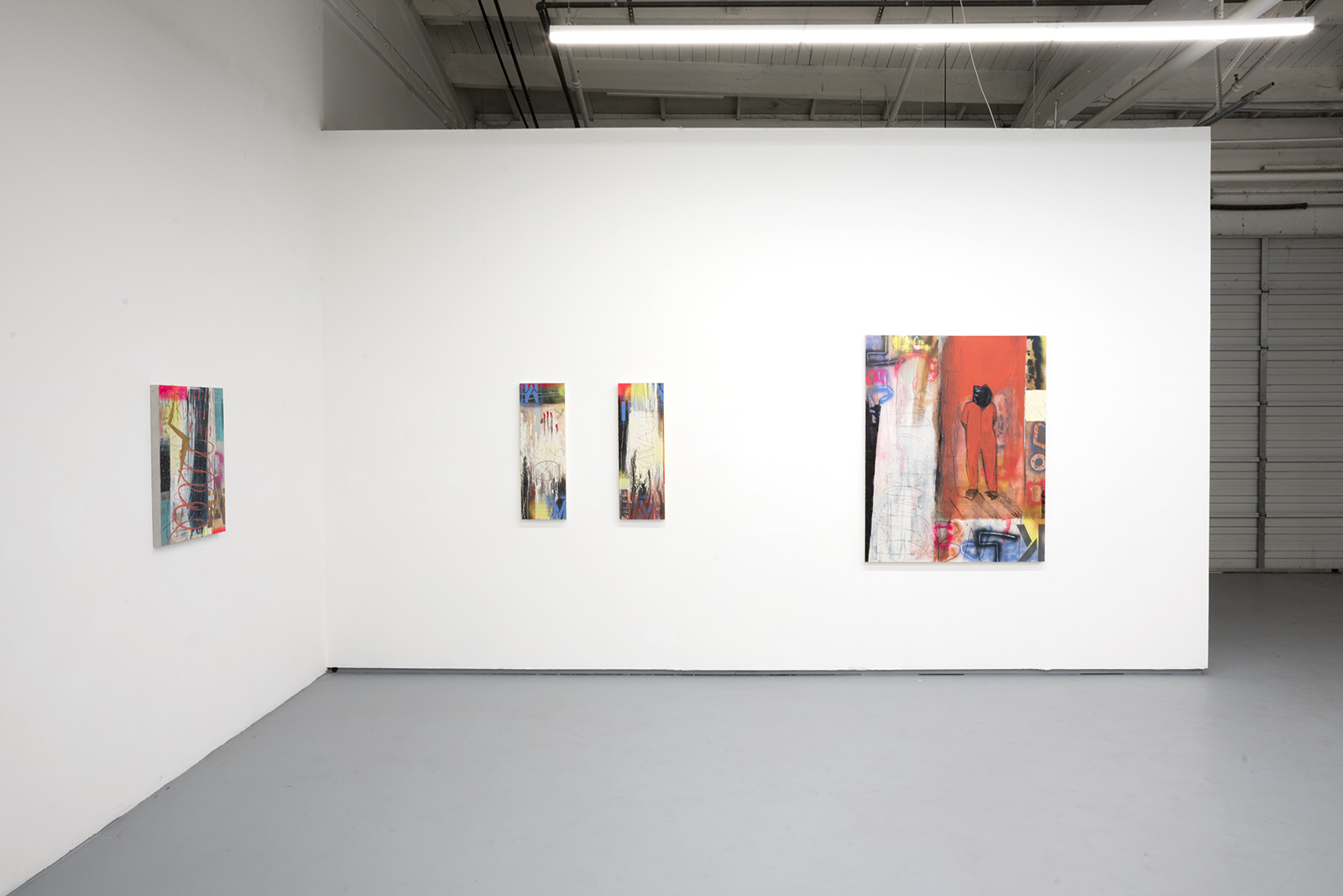Ghost Rider: Performing Fugitive Indigeneity
Ka'ila Farrell-Smith
July 31 - August 29, 2021


















‘Ghost Rider: Performing Fugitive Indigeneity’ consists of twenty-seven abstract




 paintings in the 2019-2021 Land Back series. The paintings created at my studio in Chiloquin consist of wild harvested pigments from Klamath lands and aerosol stencils of metal detritus found on the ranch land at Modoc Point Studio. Living and working on ranch and forest lands has become a ritual in reconnection. Walking the land, watching for snakes in summer, watching the prints of who walked before me in the snow in winter, selecting trees to trim for fire prevention. I collect detritus from the land: shot up cans, old ranch equipment, parts of machinery, barbed wire, grids, bullets. I take these objects and use them as stencils in my paintings. Combined, these marks with harvested wild pigments constitute layers that bridge contemplation of colonizers violence and trauma, offering a matrix for resiliency and transformation of perception and memory. Formally, the twenty seven works examine improvisational composition and abstract exploration, additional layers of thicker paint utilize text and imagery cited from my research.
paintings in the 2019-2021 Land Back series. The paintings created at my studio in Chiloquin consist of wild harvested pigments from Klamath lands and aerosol stencils of metal detritus found on the ranch land at Modoc Point Studio. Living and working on ranch and forest lands has become a ritual in reconnection. Walking the land, watching for snakes in summer, watching the prints of who walked before me in the snow in winter, selecting trees to trim for fire prevention. I collect detritus from the land: shot up cans, old ranch equipment, parts of machinery, barbed wire, grids, bullets. I take these objects and use them as stencils in my paintings. Combined, these marks with harvested wild pigments constitute layers that bridge contemplation of colonizers violence and trauma, offering a matrix for resiliency and transformation of perception and memory. Formally, the twenty seven works examine improvisational composition and abstract exploration, additional layers of thicker paint utilize text and imagery cited from my research.My chapter for the book “Transnational Feminist Art Pedagogies at the intersections of [De]Coloniality” (edited by Injeong Yoon-Ramirez and Alejandra I. Ramirez) is titled GHOST RIDER and focuses on the lynching of the Modoc War leaders as legal precedent for the 2003 US Torture program, the history of the Ghost Dance and the Iron Horse, documentation and public spectacle of lynching and torture, stopping the Jordan Cove LNG (liquid natural gas) projects in Southern Oregon, and the fugitive Indigenous pose in relation to the Land Back painting series. The writing that inspired the title of this essay as well as my 2019-2021 work is “Fugitive Indigeneity: Reclaiming the terrain of decolonial struggle through Indigenous Art” by Jarrett Martineau and Eric Ritskes, 2014.
Indigenous art evokes a fugitive aesthetic that in its decolonial ruptural forms, refuses the struggle for better or more inclusion and recognition (Coulthard, 2007) and, instead, chooses refusal and flight as modes of freedom.[1]
Indigenous Art is inherently political. (Wanda Nanibush, 2014)
The role of creative fugitivity in a corporate colonial Empire has become essential. As a content creator, writer, mark maker, and mentor, I’ve removed my labor from the urban center focusing my conceptual practice of performative painting with the land. This performance of refusal and flight is rooted in learning decolonial modes of resistance and freedom from my ancestors and contemporaries.
/
Ka'ila Farrell-Smith is a contemporary Klamath Modoc visual artist, writer and activist based in Modoc Point, Oregon. The conceptual framework of her practice focuses on channeling research through a creative flow of experimentation and artistic playfulness rooted in Indigenous aesthetics and abstract formalism. Utilizing painting and traditional Indigenous art practices, her work explores space in-between the Indigenous and western paradigms. Ka’ila displays work in the form of paintings, objects, and self-curated installations.
Ka’ila is a 2019-2020 Fields Artist Fellow with Oregon Humanities and a Board Member of Rogue Climate. Her work has been exhibited at Out of Sight, Museum of Northwest Art, Tacoma Art Museum, WA; Missoula Art Museum, MT and Medici Fortress, Cortona, Italy; and in Oregon she has work in the permanent collection of the Jordan Schnitzer Museum of Art and Portland Art Museum. She is a featured artist at SCALEHOUSE Creative in Bend, Oregon, MESH curated by Kathleen Ash-Milby at the Portland Art Museum, Many Wests: Artists Shape an American Idea at The Boise Art Museum, The Utah Museum of Fine Arts, Jordan Schnitzer Museum of Art, the Whatcom Museum, and the Smithsonian American Art Museum. Ka’ila has recently been selected to attend artist residencies at Djerassi, UCROSS, Institute of American Indian Arts, and Crow's Shadow.
Ka'ila Farrell-Smith received a BFA in Painting from Pacific Northwest College of Art and an MFA in Contemporary Art Practices Studio from Portland State University. She is a certified Wilderness First Responder and is a Land Defender on the front lines, fighting resource extraction projects across the Pacific Northwest.
[1] Martineau , Jarrett and Ritskes, Eric. “Fugitive indigeneity: Reclaiming the terrain of decolonial struggle through Indigenous art” pp. 3-4. University of Victoria, University of Toronto, 2014. Decolonization: Indigeneity, Education & Society. Vol. 3, No. 1, 2014, pp. I-XII
Ghost Rider: Performing Fugitive Indigeneity is generously supported by the Springfield Arts Commission and Oregon Arts Commission.

